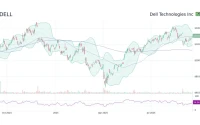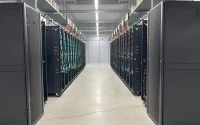I want you to look past the stock tickers for a moment. Forget the 16% jump in a single day, or even the mind-boggling 344% climb this year. What happened with Applied Digital on Friday wasn't just another Wall Street sugar high. It was a tremor. It was the sound of heavy machinery starting up in the vast, quiet plains of North Dakota, signaling that the abstract, ethereal concept of "Artificial Intelligence" is finally, physically, breaking ground.
We're so used to thinking of AI as something that lives in the cloud—a weightless, invisible force. But what we’re witnessing now is the monumental, world-shaping effort to give that cloud a home. And it’s a home made of concrete, steel, and miles of fiber optic cable. When I saw the numbers from Applied Digital’s report, it wasn't the revenue beat that caught my breath. It was the expansion of their deal with CoreWeave, a major AI infrastructure player, from an already massive $7 billion to an almost incomprehensible $11 billion in anticipated revenue. This is the kind of breakthrough that reminds me why I got into this field in the first place.
This isn’t just a contract; it’s a blueprint. It’s a declaration that the demand for raw computational power—the very engine of intelligence—is so voracious that we have to build entire new campuses, these "Polaris Forges," just to keep the lights on for the coming revolution.
The Railroads of a New Reality
Let’s put this in perspective. CEO Wes Cummins called his company the "picks and shovels of the intelligence era." It’s a fantastic, classic analogy from the Gold Rush, and he's not wrong. But I think it might even understate the scale of what's happening here. This feels less like selling tools to prospectors and more like laying the transcontinental railroad. We're not just facilitating a search for gold; we're building the very arteries of a new nation, a new economy, a new reality.
Think about it. Applied Digital is planning two massive campuses in North Dakota, Polaris Forge 1 and 2, ultimately providing 600 megawatts of capacity. A megawatt is a unit of power—in simpler terms, it's a colossal amount of electricity. A single megawatt can power hundreds of homes. Applied Digital is building the equivalent of a small city’s power grid dedicated entirely to AI computation. This is the physical, tangible, power-hungry footprint of the future, and the speed of this is just staggering—it means the gap between the AI we talk about today and the AI that will redefine our world tomorrow is closing faster than we can even comprehend.
The market is reacting to this because it’s a clear signal. While the rest of the world is mesmerized by the latest AI-generated image or chatbot response, the smart money is watching the concrete get poured. They see a company that, yes, posted a net loss of $18.5 million this quarter. But they also see a company that is aggressively investing in the single most valuable resource of the 21st century: specialized, high-density computing infrastructure. You can’t build a skyscraper from the top down. You have to spend a fortune on the foundation first. That's what we're seeing. What does it say about the future when the foundation is already worth billions?

The Insatiable Appetite of the Giants
The force driving this explosive growth is the hyperscalers. That’s the industry term for the tech titans—your Amazons, Googles, Microsofts, the giants who operate at a scale that is difficult for us to truly imagine. These are the entities expected to pour an estimated $350 billion into AI deployment this year alone. They have an almost insatiable appetite for computational power, and companies like Applied Digital are becoming the master chefs preparing the feast.
The expanded CoreWeave lease, now totaling a potential $11 billion, is a direct response to this hunger. CoreWeave serves the AI developers who need access to this immense power, and Applied Digital is building the kitchen. It’s a beautiful, symbiotic relationship that illustrates the new supply chain of intelligence.
Of course, this raises profound questions. We are building something with an energy footprint the size of a country. As we lay these new digital railroads, what is our responsibility to power them sustainably? And as this immense computational power becomes concentrated in these massive "forges," how do we ensure that the incredible tools being created there are accessible to everyone, not just the wealthiest players? This isn't just an engineering challenge; it's a deep, societal one that we have to start tackling right now, at the blueprint stage.
The stock market’s frantic energy is just a reflection of a deeper realization. We’ve moved past the theoretical. We are now in the construction phase of the age of intelligence. The debate is no longer if AI will change everything, but how quickly we can build the physical world it needs to do so.
We're Pouring the Foundation
Let's be perfectly clear about what this moment represents. The financial reports, the stock charts, the percentage points—they are all just echoes of a much more profound event. We are witnessing the physical birth of the infrastructure that will house the next era of human history. For decades, the digital revolution felt ethereal, a thing of code and light. Now, you can see it in land acquisitions, in power grid contracts, in construction timelines stretching into 2027.
This isn't just another tech boom. This is the industrial revolution for the mind. We are building the factories, the power plants, and the transit systems for thought itself. And we are just, and I mean just, getting started. What you are seeing is not the finished product. It's the sound of the first shovel hitting the dirt.









